Abstract
Mastic asphalt (MA) has been recognized as one of the most deformation-resistant and thus durable materials for bridge pavement. The performance properties of MA are highly dependent on the physical and rheological properties of the binder applied in the MA mixture. To modify the binder properties to obtain the expected performance of the MA mixture, Trinidad Lake Asphalt (TLA) is often applied. In this study, the TLA-modified binders to be used in mastic asphalt bridge pavement systems were evaluated to develop the optimum material combination using conventional and performance-related testing. Physical and rheological tests were carried out on TLA-modified binders with the different modifier content in the range of 10–50% on a weight basis. The tests revealed that the TLA modifier addition to the 35/50 base bitumen should be close to the value of 20%. Higher concentrations of TLA may make the binder very stiff and could induce low-temperature cracks in mastic asphalt.
1. Introduction
Mastic asphalt (MA or Gussasphalt) is often used for bridge pavements due to its resistance to deformation and thus high durability as well as good fluidity and self-leveling performance when laying down [1,2,3,4]. The performance properties of MA are highly dependent on the physical and rheological properties of the binder applied in the MA mixture. To modify the binder properties to obtain the expected performance of the MA mixture, Trinidad Lake Asphalt (TLA) is often applied. TLA is well recognized as an efficient bitumen modifier for its high compatibility, stability, and durability, and, thus, it is often used for bridge pavements. Modern mastic asphalt pavement usually contents a mix of penetration grade bitumen and the TLA, blended with filler (typically limestone fine aggregate) and coarse aggregate. High-quality MA pavement with the TLA-modified binder has been successfully applied for many years on hundreds of bridges [5,6,7,8].
The results of plenty of physical tests revealed that the dosage of TLA caused a reduction in penetration and an increase in softening of the base bitumen [7,9,10,11]. However, the correlation between properties of the TLA-modified binders and the performance of respective MA is not so clear due to the lack of thorough research on TLA influence on the final MA properties [7,9,11]. The TLA-modified binder properties and blend ratios are often provided in terms of physical properties because respective rheological properties are not well examined [12]. On the other hand, it is very important to characterize the rheological behavior of the TLA-modified binders to provide a rational basis for the finding of optimal material composition that will guarantee the expected MA pavement performance. The rheology of the TLA-modified binder is often recognized to have a better correlation with MA pavement performance [11,12,13]. However, describing the rheology of the TLA-modified binders by the physical parameters such as the penetration and the softening point has serious shortcomings. Thus, the understanding of rheological behavior (mainly shear viscosity) is the key factor to properly select the TLA-modified binder for the optimal MA mixture regarding performance. Consequently, a detailed assessment of the physical and rheological properties of TLA-modified binders should be carried out for optimal MA pavement performance [14,15,16].
In this study, the TLA-modified binders to be used in mastic asphalt (MA) bridge pavement systems were evaluated to develop the optimum material combination using conventional and performance-related testing. However, it is very important to emphasize that these TLA-modified binders are evaluated in the context of using them in the mastic asphalt (MA) mixture. Since the 35/50 penetration grade bitumen is the only one recommended for MA bridge pavements by the Polish road administration, it was chosen as a base bitumen in this study [17]. Moreover, 35/50 bitumen is also the most popular in Poland for other types of road pavements. Based on the available studies [9,12,18,19] and the authors’ initial research [20], the TLA content by bitumen weight up to 20% was chosen to modify the base bitumen properties towards the durable MA applications on bridges. The paper describes the evaluation of the physical and rheological properties of TLA-modified binders depending on the TLA content as well as the determination of the optimal content of TLA for the bitumen modification. The low-temperature properties of TLA-modified binders are compared to those of base bitumen to check the potential MA deformation resistance. Physical (conventional) tests and rheological tests were conducted on TLA-modified binders to achieve the mentioned objectives.
2. Materials and Methods
2.1. Materials Properties
Five combinations of the 35/50 penetration grade bitumen (base bitumen) and the Trinidad Epure TE Z 0/8 were selected to evaluate the physical and rheological properties of TLA-modified bitumen. The properties of the 35/50 bitumen in original (unaged) condition, determined according to the relevant European standards and compared with the European requirements, are listed in Table 1. Table 2 lists some of the basic properties of the TLA used in this study.

Table 1.
Basic properties of the 35/50 penetration grade bitumen.

Table 2.
Basic properties of Trinidad Lake Asphalt (TLA).
As shown in the relevant tables the base bitumen used in this study fulfilled the respective European requirements. However, in the case of TLA, small deviations from the requirements were revealed. It is due to the fact that the natural asphalt supplied by the manufacturer is covered by diatomite (an agent preventing asphalt pieces from sticking together) and is added to the mixer in this form. It was assumed in this study that the tests would be conducted on the binder delivered in the form available for the manufacturer. Hence, this form of TLA was used in the tests. This addition can stiffen the TLA resulting in deviations revealed.
2.2. Preparation of TLA-modified Binders
To obtain a homogeneous TLA-modified binder the laboratory blender was utilized to ensure appropriate mixing speed and to avoid voids in the mixture. The base bitumen and TLA were heated at 160 °C in an oven for 0.5 h to become fluid for mixing. The modifier, a specified amount of TLA, was added into liquid base bitumen with the external addition method. The temperature of the modified binders was kept at 160 °C for 1 h. After this time, the mixture was stirred at 3000 rpm for 5 min to disperse homogeneously the TLA in the base bitumen. The samples were used for tests immediately after preparation. In each physical and rheological test six samples were evaluated to obtain a statistically justified average value of the respective property.
2.3. Physical Properties Tests
The penetration test at 25 °C, softening point test, and Fraass breaking point test were performed to evaluate the physical properties of the 35/50 bitumen, the TLA and the TLA-modified binders. The penetration tests were performed according to the European standard [21] to evaluate the hardness of bitumen, TLA and binders. The softening point tests were performed according to the European standard [22] to determine the temperature at which a phase change occurs in bitumen, TLA and binders. The Fraass breaking point test following the European standard [23] was undertaken to evaluate the brittleness of bitumen and binders at low temperatures. The results of the physical tests of the base bitumen and the TLA are given in Table 1 and Table 2, while the results for the TLA-modified binders are given in Table 3.

Table 3.
Basic physical properties of TLA-modified binders.
The conventional mixing formulas (1) and (2) were also used to determine the penetration and softening point of the TLA-modified binders as follows [28]:
where:
- Pmix—the estimated penetration of the modified binder;
- SPmix—the estimated softening point of the modified binder;
- PA and PB—the measured penetrations of two components: base bitumen (A) and TLA (B), respectively;
- SPA and SPB—the measured softening points of two components: base bitumen (A) and TLA (B), respectively;
- a and b—the proportions of components (A) and (B) in the mixture, respectively (a + b = 1).
Additionally, the plasticity range and the penetration index were determined using the experimental values of penetration, softening point, and Fraass breaking point. The plasticity range (PR) is the difference between the softening point and the Fraass breaking point in [°C]. Within the plasticity range, the binder maintains its viscoelastic properties. The penetration index (IP) is a dimensionless value to measure of temperature sensitivity of the binder. The lower the penetration index, the greater the temperature sensitivity of the binder. The determination of the penetration index according to the European standard [25] assumes that the binder at the softening point has penetration equal to 800 [0.1 mm].
However, the applicability of these physical parameters to evaluate temperature sensitivity and the viscous properties of binders is relatively often questioned. Instead, the dynamic shear rheometer (DSR) tests are used to determine these binder properties. Moreover, to evaluate the pavement performance regarding deformation or cracking under extreme service temperatures, the determination of the rheological parameters (complex modulus, phase angle, etc.) of the binders seems to be a more reliable method [10,11,12].
2.4. Rheological Properties Tests
Sinusoidal oscillation loading was utilized to undertake the dynamic shear rheological test (DSR). The DSR measures a sample’s complex shear modulus (G*) and phase angle (δ). The first parameter can be considered as the sample’s total resistance to deformation when shear loaded, while the latter is the lag between the applied shear stress and the resulting shear strain. Typically, the higher the G* value, the stiffer the binder is (able to resist deformation), and the lower the δ value, the greater the elastic portion of G* is (able to recover its original shape after being deformed by a load).
However, based on the SHRP specification, Bahia [29] suggests the use of these two parameters (G*, δ) at a fixed temperature and frequency of testing. Since the viscosity of the binder changes with temperature and the elastic properties of the binder change with the frequency of loading, the above parameters have been suggested to be ineffective in predicting the rutting performance of binders, especially in the case of modified binders [30,31,32,33]. Rutting parameter G*/sinδ does not fully evaluate the delayed elasticity—this parameter measures a short loading time, which is representative of traffic loading. For some binders, this process is long, which leads to underestimating the resistance to permanent deformation. A parameter that includes both features is the zero shear viscosity (ZSV) [34]. The concept of ZSV was introduced by Sybilski [35] to evaluate the contribution of binders to the rutting resistance of bitumen pavements. ZSV is a suitable indicator to evaluate the partial contribution of the binder to the rutting resistance of bitumen pavement layers. Thus, in this study, the ZSV of TLA-modified binders was calculated using different models and test methods.
The available literature describes many test methods for the experimental determination of ZSV of binders based on the use of DSR under different experimental conditions, both oscillatory and creep mode [36,37,38]. In this study, ZSV was determined with two different test modes: frequency sweep test and creep test. Following the preparation of the modified binders, both rheological tests were conducted using DSR for original (unaged) samples. For both rheological tests, the Grubbs test was carried out to detect outliers in a univariate data set assumed to come from a normally distributed population. To calculate the ZSVs of the modified binders, the Cross model was fitted to measure the complex viscosity (η*).
2.4.1. Frequency Sweep Test
The dynamic oscillatory tests according to the European standard [39] using a HAAKE RheoStress 1 Rheometer were carried out. The test geometry with a 25 mm diameter plate and 1 mm gap was used. A constant strain of 5% was applied over a range of test temperatures (between 40 °C and 60 °C with an increment of 10 °C) and frequencies (between 0.01 and 100 Hz). All tests were performed in the linear viscoelastic range.
The Cross model was used to estimate a zero shear viscosity of the modified binders [40]. The Cross model describes flow curves of the modified binder in the form of a four-parameter function as follows:
where:
- is the complex viscosity;
- is the ZSV;
- is the limiting viscosity in the second Newtonian region;
- is the angular frequency [rad/s];
- K and m are constants.
The HAAKE RheoWin, a complete measuring and evaluation software package was used to control the rheometer and to handle the measured data with the selected rheological evaluation method. In this study the Cross model material parameters (, , K, m) were determined with this software.
2.4.2. Creep Test
ZSV () can be also determined by a creep test, in which the load is applied until a steady state is obtained. ZSV in the creep mode is typically determined using a rheometer and in the temperature domain. In this rheological test, the constant direct shear stress is applied to a sample and the resulting deformation is measured as a function of loading time. The viscosities were calculated by Equation (4) using the Burgers model [41]:
where:
- is the steady state viscosity (SSV) [Pa·s];
- is time period [s];
- is the difference compliance over the last 15 min [1/Pa];
- is the compliance measured at the end of the creep test [1/Pa];
- is the compliance 15 min before the load is removed [1/Pa].
In the creep method, ZSV was determined according to the CEN standard [42] at the specified temperatures: +40 °C, +50 °C, and +60 °C. The same test configuration with a 25 mm diameter plate and 1 mm gap was used. The test consisted of two steps: in the first step, a stress sweep was executed to select the creep test stress and in the second step the creep test was performed with the selected stress for a sufficiently long time to reach steady-state flow. The applied shear stress was τ = 50 Pa.
3. Results and Discussion
3.1. TLA Content Effect on Physical Properties of Modified Binders
The physical properties determined for the TLA-modified binders are given in Table 3 and the following Figure 1, Figure 2, Figure 3, Figure 4 and Figure 5. Generally, as expected, the test results presented in Table 3 show higher stiffness, higher softening temperature, and higher brittleness temperature obtained for all modified binders as compared to the base 35/50 bitumen.
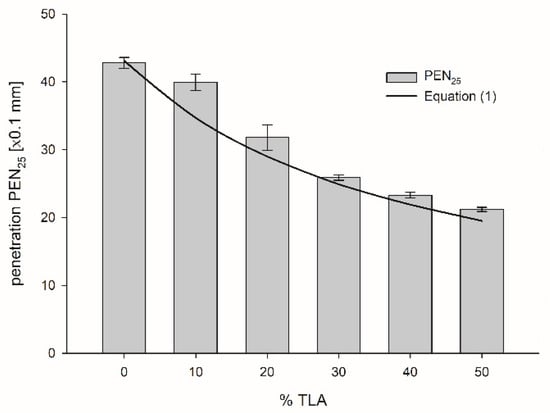
Figure 1.
Penetration of TLA-modified binders.
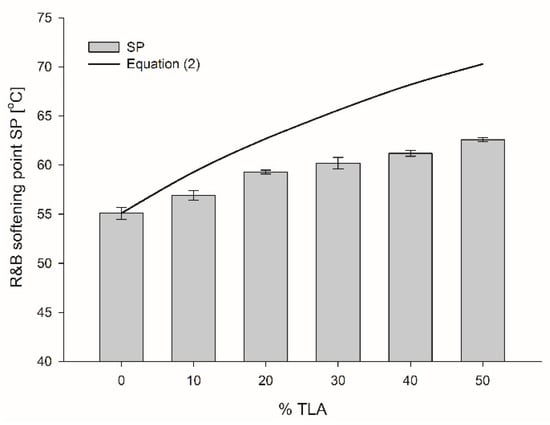
Figure 2.
Softening point of TLA-modified binders.
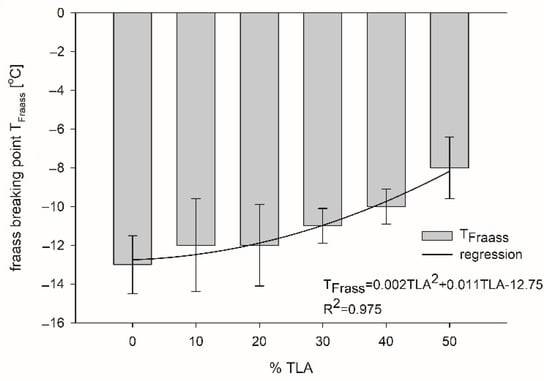
Figure 3.
Fraass breaking point of TLA-modified binders.
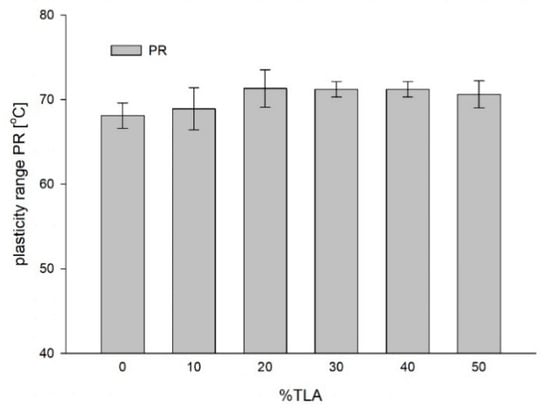
Figure 4.
Plasticity range of TLA-modified binders.
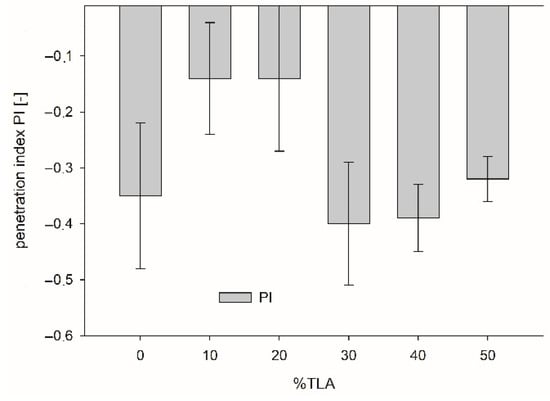
Figure 5.
Penetration index of TLA-modified binders.
As shown in Figure 1, the penetration value depends on the TLA content; the base bitumen was stiffened by the addition of TLA. The penetration proportionally decreases with increasing TLA content to a level of less than 50%. The TLA concentration of more than 30% changes the grade of bitumen into 20/30 penetration. A 50.4% decrease of penetration was obtained for the 50% TLA-modified binder. The mixture Equation (1) was used to predict the penetration reduction of the modified binder. However, the calculated values were slightly lower than the measured values.
Figure 2 shows that the softening point proportionally increases with increasing TLA content. For the 30% TLA-modified binder, the softening point is close to the upper limit of the service temperature under Polish climate conditions [43]; for higher TLA content, the softening point is above this limit. The softening point of TLA-modified binders was also determined by the mixture formula (2). The formula (2) does generally not fit measured values and the calculated values overestimate the measured ones. The softening point difference between calculated and measured values is proportional to the TLA content and increases with the TLA content.
The Fraass breaking point for the modified binders is shown in Figure 3. It is in the range of −12 °C to −8 °C. The increase of the TLA content in base bitumen increases the Fraass breaking point accordingly. The only exception to that was the 20% content of TLA, where the Fraass breaking point is almost the same as the one with 10% TLA. The relationship between the Fraass breaking point temperature and the TLA content was established in the form of a quadratic equation with quite good correlation (R2 = 0.975).
The temperature plasticity range of the modified binders is in the range of 68.9 °C to 71.3 °C, which is only slightly higher than the range for the base bitumen (Figure 4). From these results, one can see that the TLA content has only a small effect on the plasticity range. All results are close to the most desired temperature range (about 80 °C), a conventional temperature range in which the binder exhibits the best viscoelastic behavior. However, the test results show higher softening temperature and higher brittleness temperature obtained for all modified binders as compared to base bitumen.
The penetration index value was determined based on penetration at 25 °C and the softening point temperature. The IP values range from −0.39 to −0.14 (Figure 5). All of the tested binders have an IP value falling within the range recommended in the European standard [25], i.e., from −1.5 to 0.7. However, the binders modified with 10% and 20% of TLA content has an IP value slightly higher (−0.14) than the rest of the bitumen; they have an IP value in the range of −0.32 to −0.40, similar to the base bitumen. The addition of 10% to 20% of TLA by weight has a good effect on IP value because the increase of IP in the modified binder causes a decrease of temperature susceptibility of bitumen, which is beneficial in terms of deformation resistance of pavement. Thus, the TLA content in the range from 10% to 20% in the modified 35/50 base bitumen seems to be the optimal value for increasing the stiffness and reducing the temperature sensitivity, which is desirable for bitumen.
3.2. TLA Content Effect on Rheological Properties of Modified Binders
3.2.1. Complex Modulus and Phase Angle
The plots of the complex modulus (G*) and phase angle (δ) versus frequency at test temperature from 40 °C to 60 °C and various TLA content levels are shown in Figure 6. The TLA content has a huge impact on stiffness (G*) and viscous response (δ) of the modified binders. As expected, the addition of TLA in 35/50 bitumen resulted in increased stiffness of the modified binders. The isothermal curves in Figure 6 clearly show that the TLA content resulted in a vertical shift of the (G*) curve to higher values but without the change of the curve shape. Consistent with trends observed in the viscoelastic response, the (G*) value of the binders increased as the temperature of the test was reduced. The (G*) value at the test temperature in the range of 40 °C to 60 °C increased with increasing load frequency. Figure 6 also shows that for all binders the phase angle (δ) decreased with increasing frequency, suggesting a more elastic response with loading time decreasing at each test temperature. Moreover, the TLA content in the base bitumen increased the elastic response, as shown by the reduction of the (δ) value due to an especially high elastic response in TLA. These characteristics are comparable with those observed in the base bitumen.

Figure 6.
Isothermal curves of TLA-modified binders at (a) 40 °C; (b) 50 °C; (c) 60 °C.
The complex modulus (G*) and phase angle (δ) of the TLA-modified binders versus test temperature are shown in Figure 7. At a specific test temperature, the complex moduli of the modified binders were higher than that of base bitumen. The G* value increased with the increase of TLA content, which reveals that the modified binders had a better deformation resistance. The phase angle decreased gradually with TLA content increasing, showing that at a specific temperature the modified binders with higher TLA content were more elastic than those with lower content.
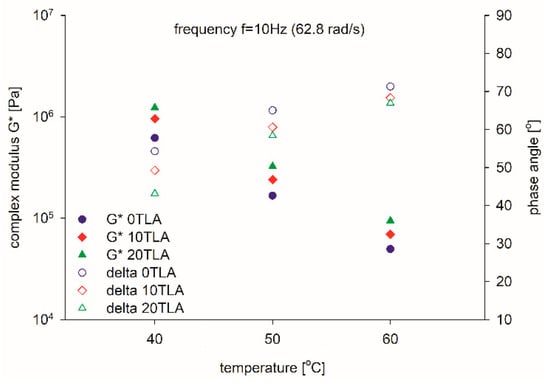
Figure 7.
Complex modulus (G*) and phase angle (δ) of TLA-modified binders.
Figure 8 presents the black curves of the TLA-modified binders, i.e., the plots of complex modulus (G*) versus phase angle (δ) with no reference to frequency or temperature, used mostly for evaluation of differences in bitumen products. The effects caused by modification are highlighted by this form of presentation. Figure 8 shows that the modified binders have black curves very well comparable to that of the base bitumen; however, none shifted towards a stiffer and more elastic response. Typically, a modified binder has a lower phase angle than the base bitumen.

Figure 8.
Black curves of TLA-modified binders at (a) 40 °C; (b) 50 °C; (c) 60 °C.
3.2.2. Zero Shear Viscosity
The ZSV values determined for the TLA-modified binders are shown in Table 4 depending on the test method (frequency sweep test or creep test) and test temperature.

Table 4.
ZSV of TLA-modified binders.
The measured and calculated (based on the Cross model) data of complex viscosities (η*) versus the angular frequency (ω) in the temperature range of 40 °C to 60 °C are shown in Figure 9 on a log-log plot. At any frequency, the TLA addition increased the complex viscosity (η*) and the viscosity stiffening effect of TLA depends on the TLA content at a specific temperature. The higher the TLA concentration, the stiffer the modified binder, which is compatible with the physical test results. The plots show that at the specific temperature the base bitumen was similarly frequency-dependent as the TLA-modified binders. For all binders, the complex viscosity (η*) generally decreased with the load frequency (ω) increase, pointing out that at the tested temperature the TLA-modified binders tend towards base bitumen behavior. As shown in Figure 9, for the modified binders the slopes of the curves at 50 °C are flatter comparing to the slopes at 40 °C and 60 °C.

Figure 9.
Measured and calculated viscosities versus angular frequency on a log-log plot at (a) 40 °C; (b) 50 °C; (c) 60 °C.
The high compliance of viscosity values between the calculated (i.e., based on the Cross model) and measured data ranging from 0.01 to 100 Hz is shown in Figure 9. Therefore, the ZSV values for the TLA-modified binders could be determined at zero shear conditions. The results show that the TLA modification of the base bitumen increased the ZSV value at a specific temperature.
A decrease of the ZSV was revealed with the TLA content decrease and the test temperature increase (Figure 10). The highest ZSV increase was determined at 40 °C; more than two-fold ZSV increase was obtained for 10% TLA content and about the three-fold increase for 20% TLA comparing to the base bitumen. At the remaining temperatures, the relevant ZVS increases were lower: 1.7 and 2.5 at 50 °C and 1.6 and 2.4 at 60 °C, for 10% and 20% TLA, respectively (Figure 11).
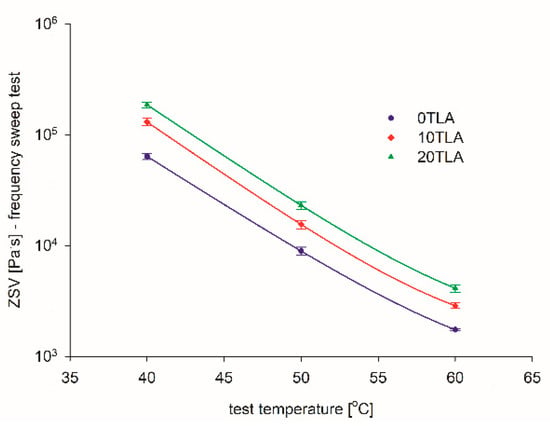
Figure 10.
ZSV from the Cross model versus test temperature and TLA content on a semi-log plot.
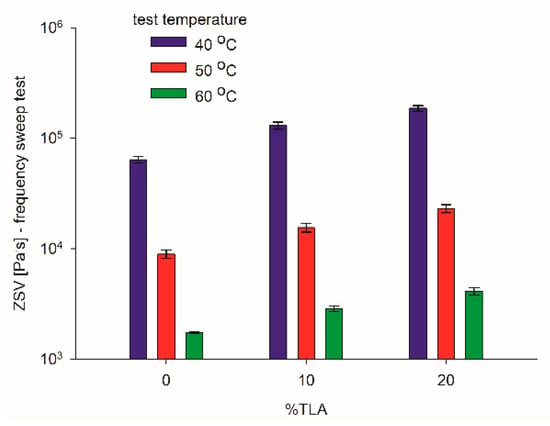
Figure 11.
ZSV from the Cross model for various TLA content and test temperatures.
Similar results of ZSV as for frequency sweep test were obtained from creep test and are shown in Figure 12, Figure 13 and Figure 14. In Figure 12, the creep curves for TLA-modified binders at the specific temperature are plotted. For each TLA content at the specific temperature, the sample has reached a steady-state in the last 15 min of the test. The TLA addition increased the viscosity stiffening effect of TLA, which was revealed by much smaller deformations at the same shear load 50 Pa. The stiffening effect of TLA depends on the specific test temperature. The higher the test temperature, the lower the stiffening effect of TLA and the greater increase in creep deformation obtained. The shape of creep curves is similar, which reveals the stiffening effect of TLA, not the modification of the binder character itself.

Figure 12.
Creep curves for TLA-modified binders at (a) 40 °C; (b) 50 °C; (c) 60 °C.
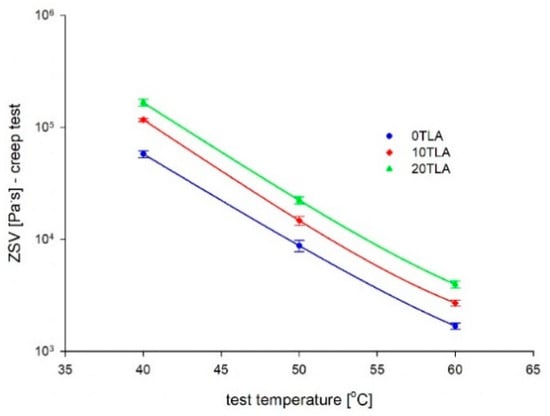
Figure 13.
ZSV from creep test versus test temperature and TLA content on a semi-log plot.
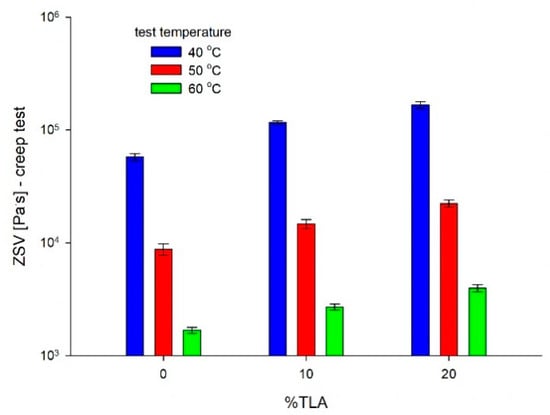
Figure 14.
ZSV from creep test for various TLA content and test temperatures.
Just as with the frequency sweep test, a proportional decrease of the ZSV was obtained with a decrease of TLA content and an increase of the test temperature (Figure 13). The highest ZSV increase was observed at 40 °C; the two-fold ZSV increase was obtained for 10% TLA content and slightly less than the three-fold increase for 20% TLA compared to the base bitumen. At the remaining temperatures, the relevant ZVS increases were lower: 1.7 and 2.5 at 50 °C and 1.6 and 2.4 at 60 °C, for 10% and 20% TLA, respectively (Figure 14).
3.2.3. Comparison of Two Methods of Rheological Testing
The rheological testing carried out in this study evaluated two methods for determining the ZSV of modified binders. The values determined in the creep test versus the values calculated using the Cross method are shown in Figure 15. A good correlation is revealed between both methods (the difference between the two methods is within 10%), and, thus, the Cross method can be reliably used to obtain the ZSV for the TLA-modified binders tested in this study. There are no significant outliers in the entire range of ZSV values.
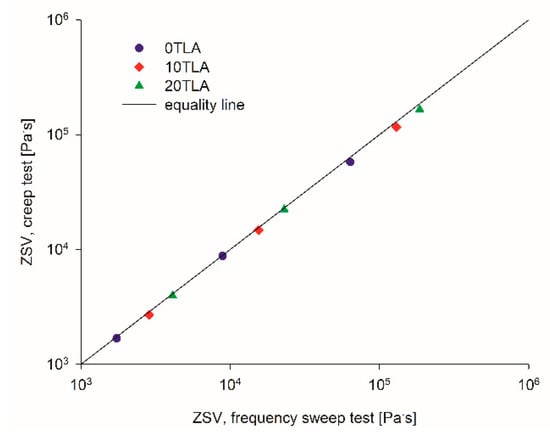
Figure 15.
ZSV from creep test versus ZSV from the Cross model.
4. Conclusions
A comprehensive investigation of TLA-modified binders was presented in this study. The most popular base bitumen with 35/50 grade penetration was modified with five different TLA content in the range of 10% to 50% by weight. The physical and rheological tests were performed in the laboratory to evaluate the relevant properties of TLA-modified binders. The following observations were made as a result of the study:
- The addition of TLA to the 35/50 base bitumen caused the penetration reduction and the softening point increase, as expected based on previous research. These physical values were proportional to the TLA content of less than 50%.
- The penetration and softening point values were not exactly anticipated by the conventional mixture formulas. The calculated penetration values were lower than the measured ones, while the predicted values of the softening point were overestimated.
- TLA content of less than 50% caused an increase of the complex modulus (G*) and a reduction of the phase angle (φ) of the base bitumen, indicating that the addition of TLA into 35/50 bitumen results in increased stiffness and elastic response of the modified binder. This also reveals that the TLA-modified binder has a better deformation resistance.
- The DSR test revealed an increase of viscosity value at each temperature after the addition of TLA. The higher the TLA content, the stiffer the modified binder, which is compatible with the physical test results. For all binders the complex viscosity (η*) generally decreased with load frequency (ω) increase, highlighting that, at the tested temperature, the TLA-modified binders tend towards base bitumen behavior.
- The ZSV decrease was observed with a decrease in TLA content and an increase in the temperature. The highest ZSV increase was observed at 40 °C; more than a two-fold ZSV increase was obtained for 10% TLA content and about the three-fold increase for 20% TLA compared to the base bitumen.
- Within the diversity of the binders and the test temperature range, the very comparable ZSV values were obtained using both testing methods, i.e., the Cross method and the creep method. This study revealed that ZSV may be reliably determined from either frequency sweeps or single cycle creep tests.
- The TLA content added as a modifier in the 35/50 base bitumen should be in the range of 10% to 20% by weight. Higher contents of TLA may make the binder very stiff, which could induce low-temperature cracks in mastic asphalt.
- The TLA-modified binders can enhance the deformation resistance of base bitumen by increasing the stiffness and extending the durability of the respective mastic asphalt bridge pavement.
The main findings of the current study let us anticipate how the TLA content in base bitumen can improve the properties of an MA mixture to make it more resistant to plastic deformations under heavy traffic. The research results revealed the appropriate TLA content for the 35/50 base bitumen as one of the possible solutions for MA against those reported in the literature, i.e., application of harder asphalt 20/30 or softer asphalt 50/70 with more TLA content (30%). Thus, the supplier and/or contractor can choose the binder (base bitumen and appropriate modification) and, taking into account both technological and economical aspects, use the best composition to achieve a durable MA pavement, resistant to plastic deformations.
Further research should include testing the TLA-modified binder properties after short-term aging and long-term aging and finally composing and testing the resultant mastic asphalt mixture to confirm its adequate resistance to plastic deformations. Furthermore, based on the literature, it can be concluded that ZSV is a good parameter of resistance to permanent deformation of conventional asphalt mixtures. However, it has not been studied more extensively in the context of mastic asphalt. This was one of the reasons why the authors took up this issue. In further studies, the ZSV will be used to estimate the appropriate amount of TLA for use in mastic asphalt in bridge pavement.
Author Contributions
Conceptualization, K.K. and L.B.; methodology K.K.; investigation, K.K.; resources, L.B. and T.S.; data curation, K.K.; writing—original draft preparation, K.K.; writing—review and editing, T.S. and L.B.; visualization, K.K.; supervision, T.S.; project administration, K.K.; funding acquisition, T.S. All authors have read and agreed to the published version of the manuscript.
Funding
This research was funded by the POLISH MINISTRY OF SCIENCE AND HIGHER EDUCATION, grant number DS/M.BC.17.001. The APC was funded by the RZESZOW UNIVERSITY OF TECHNOLOGY, Poland.
Informed Consent Statement
Not applicable.
Data Availability Statement
The data presented in this study are available on request from the corresponding author.
Acknowledgments
The authors wish to acknowledge PKN Orlen, Poland, for supplying bitumen and CMS Polska, Poland, for supplying Trinidad Lake Asphalt.
Conflicts of Interest
The authors declare no conflict of interest. The funders had no role in the design of the study; in the collection, analyses, or interpretation of data; in the writing of the manuscript, or in the decision to publish the results.
References
- Park, H.M.; Choi, J.Y.; Lee, H.J.; Hwang, E.Y. Performance evaluation of a high durability asphalt binder and a high durability asphalt mixture for bridge deck pavements. Constr. Build. Mater. 2009, 23, 219–225. [Google Scholar] [CrossRef]
- Radziszewski, P.; Piłat, J.; Sarnowski, M.; Kowalski, K.; Król, J. Influence of high temperature on properties of materials used in bridge asphalt pavement structures. Roads Bridg Drog i Most 2015, 14, 175–191. [Google Scholar]
- Zou, G.; Zhang, X.; Wu, C. Experimental method of fatigue performance of mastic asphalt for bridge deck pavement. Balt. J. Road Bridg. Eng. 2019, 14, 568–586. [Google Scholar] [CrossRef]
- Zou, G.; Xu, X.; Li, J.; Yu, H.; Wang, C.; Sun, J. The effects of bituminous binder on the performance of gussasphalt concrete for bridge deck pavement. Materials 2020, 13, 364. [Google Scholar] [CrossRef] [PubMed]
- Widyatmoko, I.; Elliott, R.C.; Read, J.M. Development of heavy-duty mastic asphalt bridge surfacing, incorporating Trinidad lake asphalt and polymer modified binders. Road. Mater. Pavement. 2005, 6, 469–483. [Google Scholar] [CrossRef]
- Russel, M.; Uhlmeyer, J.S.; Anderson, K.; Weston, J. Evaluation of Trinidad Lake Asphalt Overlay Performance; Washington State Department of Transportation: Olympia, WA, USA, 2008.
- Mitchell, M.; Link, R.; Cao, W.-D.; Yao, Z.; Liu, S.; Cui, X. Performance of composite modified asphalt with Trinidad lake asphalt used as waterproofing material for bridge deck pavement. J. Test. Eval. 2009, 37, 463–467. [Google Scholar] [CrossRef]
- Jian-Shiuh, C.; Min-Chih, L.; Chien-Chung, H.; Ching-Hsiung, W. Fundamental characterization of engineering properties of gussasphalt mixtures. J. Mater. Civ. Eng. 2011, 23, 1719–1726. [Google Scholar]
- Widyatmoko, I.; Elliott, R. Characteristics of elastomeric and plastomeric binders in contact with natural asphalts. Constr. Build. Mater. 2008, 22, 239–249. [Google Scholar] [CrossRef]
- Maharaj, R. A comparison of the composition and rheology of Trinidad lake asphalt and Trinidad petroleum bitumen. Int. J. Appl. Chem. 2009, 5, 169–179. [Google Scholar]
- He, R.; Zheng, S.; Chen, H.; Kuang, D. Investigation of the physical and rheological properties of Trinidad lake asphalt modified bitumen. Constr. Build. Mater. 2019, 203, 734–739. [Google Scholar] [CrossRef]
- Liao, M.; Chen, J.; Airey, G.D.; Wang, S. Rheological behavior of bitumen mixed with Trinidad lake asphalt. Constr. Build. Mater. 2014, 66, 361–367. [Google Scholar] [CrossRef]
- Li, R.; Wang, P.Z.; Xue, B.; Pei, J.Z. Experimental study on aging properties and modification mechanism of Trinidad lake asphalt modified bitumen. Constr. Build. Mater. 2015, 101, 878–883. [Google Scholar] [CrossRef]
- Sang, L.; Zhendong, Q.; Xu, Y.; Hui, W. Design of gussasphalt mixtures based on performance of gussasphalt binders, mastics and mixtures. Constr. Build. Mater. 2017, 156, 131–141. [Google Scholar]
- Chen, X.; Liu, X.; Qian, Z.; Lei, Z. State-of-art of asphalt surfacings on long-spanned orthotropic steel deck in China. In Proceedings of the ISAP International Symposium on Heavy Duty Asphalt Pavements and Bridge Deck Pavements, Nanjing, China, 23–25 May 2012. [Google Scholar]
- Chunfu, X.; Qing, L.; Changfa, A.; Ali, R.; Yanjun, Q. Optimization of hard modified asphalt formula for gussasphalt based on uniform experimental design. Constr. Build. Mater. 2017, 136, 556–564. [Google Scholar]
- WT-2-Technical Recommendations for Asphalt Pavements on National Roads; General Directorate for National Roads and Motorways: Warsaw, Poland, 2014.
- Xu, S.; Hu, C.; Yu, J.; Liu, R.; Zhou, X. Influence of Trinidad Lake Asphalt on the physical and anti-aging properties of petroleum asphalt. Pet. Sci. Technol. 2017, 35, 2194–2200. [Google Scholar] [CrossRef]
- Słowik, M.; Bilski, M. An experimental study of the impact of aging on Gilsonite and Trinidad Epuré modified asphalt binders properties. Balt. J. Road Bridge E 2017, 12, 71–81. [Google Scholar] [CrossRef]
- Kołodziej, K.; Bichajło, L. Effect of natural asphalt TLA on mastic asphalt ageing. J. Civ. Eng. Environ. Archit. JCEEA 2016, 33, 233–241. (In Polish) [Google Scholar]
- PN-EN 12591: 2010. Bitumen and Bituminous Binders-Specification for Paving Grade Bitumens; Polish Committee for Standardization: Warsaw, Poland, 2010.
- PN-EN 1426: 2015-08. Bitumen and Bituminous Binders-Determination of Needle Penetration; Polish Committee for Standardization: Warsaw, Poland, 2015.
- PN-EN 1427: 2015-08. Bitumen and Bituminous Binders-Determination of the Softening Point-Ring and Ball Method; Polish Committee for Standardization: Warsaw, Poland, 2015.
- PN-EN 12593: 2015-08. Bitumen and Bituminous Binders-Determination of the Fraass Breaking Point; Polish Committee for Standardization: Warsaw, Poland, 2015.
- PN-EN 15326: 2010. Bitumen and Bituminous Binders-Measurement of Density and Specific Gravity-Capillary-Stoppered Pyknometer Method; Polish Committee for Standardization: Warsaw, Poland, 2010.
- PN-EN 13108-4: 2016-07. Bituminous Mixtures-Material Specifications-Part 4: Hot Rolled Asphalt; Polish Committee for Standardization: Warsaw, Poland, 2016.
- PN-EN 12592: 2010. Bitumen and Bituminous Binders–Determination of Solubility; Polish Committee for Standardization: Warshaw, Poland, 2010.
- Read, J.; Whiteoak, D. The Shell Bitumen Handbook; Thomas Telford Publishing: London, UK, 2003. [Google Scholar]
- Bahia, H.U. Critical evaluation of asphalt modification using strategic highway research program concepts. Transp. Res. Record. 1995, 1488, 82–88. [Google Scholar]
- Philips, M.; Robertus, C. Binder Rheology and Asphaltic Pavement Permanent Deformation: The Zero-Shear-Viscosity. In Proceedings of the Eurasphalt & Eurobitume Congress, Strasbourg, France, 7–10 May 1996; European Asphalt Pavement Association: Brussels, Belgium, 1996; p. 12. [Google Scholar]
- Desmazes, C.; Lecompte, M.; Lesueur, D.; Philips, M. A protocol for Reliable Measurement of Zero-Shear Viscosity in Order to Evaluate the Anti-Rutting Performance of Binders. In Proceedings of the 2nd Eurasphalt and Eurobitume Congress, Barcelona, Spain, 20–22 September 2000; Foundation Eurasphalt: Ermelo, The Netherlands, 2000; pp. 203–211. [Google Scholar]
- De Visscher, J.; Vanelstraete, A. Practical test methods for measuring the zero shear viscosity of bituminous binders. Mater. Struct. 2004, 37, 360–364. [Google Scholar] [CrossRef]
- Delgadillo, R.; Nam, K.; Bahia, H. Why do we need to change G*/sinδ and how? Road Mater. Pavement. 2006, 7, 7–27. [Google Scholar] [CrossRef]
- Abdullah, N.H.; Hamzah, M.O.; Yusoff, N.I.; Valentin, J. Determination of the zero shear viscosity of binder-filler mastic using Cross and Carreau models. Asian Transp. Stud. 2018, 5, 165–176. [Google Scholar]
- Sybilski, D. Zero-shear viscosity of bituminous binder and its relation to bituminous mixture’s rutting resistance. Transp. Res. Record 1996, 1535, 15–21. [Google Scholar] [CrossRef]
- Binard, C.; Anderson, D.; Lapalu, L.; Plache, J.-P. Zero Shear Viscosity of Modified and Unmodified Binders. In Proceedings of the 3rd Eurasphalt and Eurobitume Congress, Vienna, Austria, 12–14 May 2004; European Asphalt Pavement Association: Brussels, Belgium, 2004; pp. 1721–1733. [Google Scholar]
- Marasteanu, M.; Clyne, T.; McGraw, J.; Li, X.; Velasquez, R. High-temperature rheological properties of asphalt binders. Transp. Res. Record 2005, 1901, 52–59. [Google Scholar] [CrossRef]
- Mazurek, G.; Iwański, M. Estimation of zero shear viscosity versus rutting resistance parameters of asphalt concrete. Proc. Eng. 2016, 161, 30–35. [Google Scholar] [CrossRef]
- PN-EN 14770: 2009. Bitumen and Bituminous Binders-Determination of Complex Shear Modulus and Phase Angle-Dynamic Shear Rheometer (DSR); Polish Committee for Standardization: Warsaw, Poland, 2009.
- Cross, M.M. Rheology of non-newtonian fluids: A new flow equation for pseudoplastic systems. J. Coll. Sci. Imp. U. Tok. 1965, 20, 417–437. [Google Scholar] [CrossRef]
- Saboo, N.; Mudgal, A. Modelling creep and recovery response of asphalt binders using generalized Burgers model. Pet. Sci. Technol. 2018, 36, 1627–1634. [Google Scholar] [CrossRef]
- CEN/TS 15325: 2008. Bitumen and Bituminous Binders-Determination of Zero-Shear Viscosity (ZSV) Using a Shear Stress Rheometer in Creep Mode; Comite Europeen de Normalisation: Brussels, Belgium, 2008.
- Błażejowski, K.; Styk, S. Asphalt Pavements Technology; Wydawnictwa Komunikacji i Łączności: Warszawa, Poland, 2004. (In Polish) [Google Scholar]
Publisher’s Note: MDPI stays neutral with regard to jurisdictional claims in published maps and institutional affiliations. |
© 2021 by the authors. Licensee MDPI, Basel, Switzerland. This article is an open access article distributed under the terms and conditions of the Creative Commons Attribution (CC BY) license (http://creativecommons.org/licenses/by/4.0/).